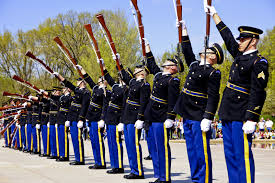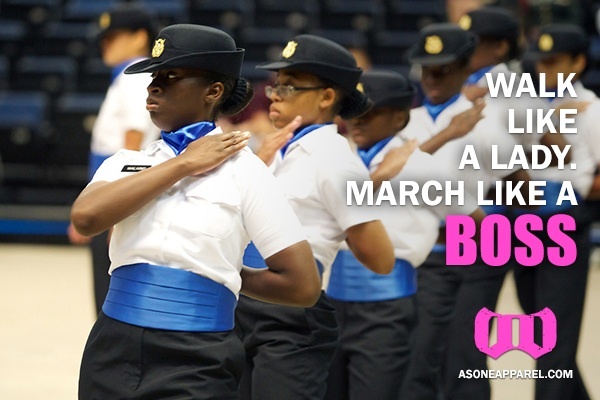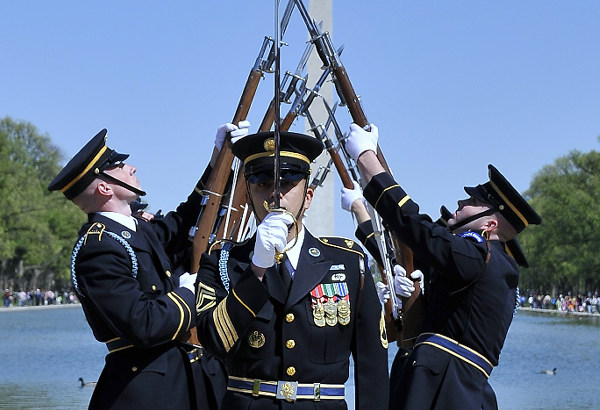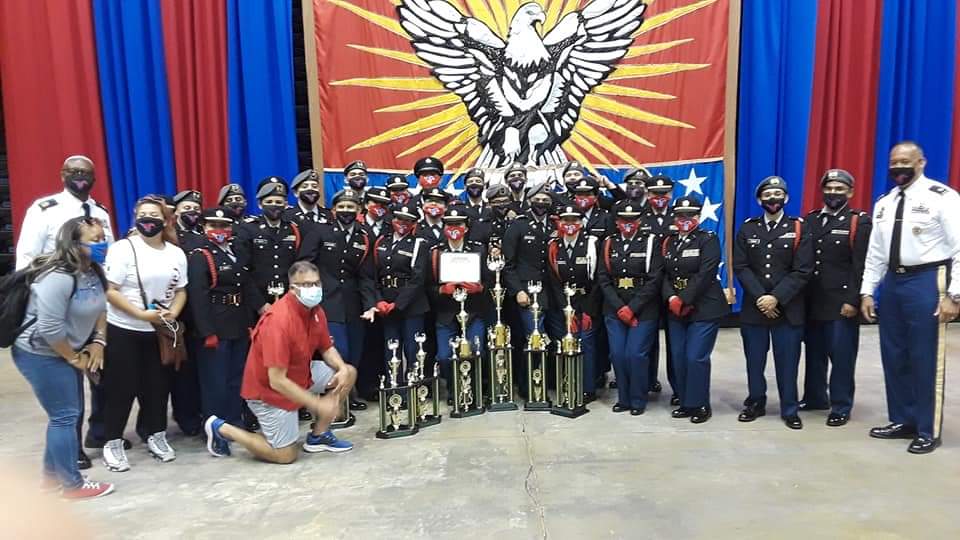DRILL HALL OF FAME
QUICK LINKS
HISTORICAL INFLUENCES
- Baron Friedrich von Steuben*
- John "Black Jack" Pershing* &
the Pershing Rifles
ORGANIZATIONS &
THEIR GUIDING FORCE
- The United States Air Force
Honor Guard Drill Team
- The United States Army
Drill Team (The Old Guard)
- The United States Marine Corps
Silent Drill Platoon
- Mr. Paul Naki & The King's Guard
- The National High School
Drill Team Championships &
Sports Network International
- Mr. Constantine H. Wilson* &
New Guard America
SCHOOLS & INSTRUCTORS
- MSG Larry Badia &
the Patriot Guard/Patriot Pride
Fresh Meadows, New York
- CMS R. Wayne Barron
AF Reginal Director - Maxwell AFB, Alabama
- Blue Aces Unarmed Drill Team
Brandeis H.S.
San Antonio, Texas
- LCDR Ken Bingham/Chief Edwin Morales
and the Boca Raton H.S. NJROTC Drill Team
of
Boca Raton H.S. - Boca Raton, Florida
- "The Machine"/"The Guard"
Central Catholic H.S.
San Antonio, Texas
- Fish Drill Team
Texas A&M University
College Station, Texas
- LtCol Peter Duggan*/Captain Joe Mathews*
of
Lincoln H.S. - Yonkers, New York
- MGySgt Douglas Dunlapp &
the Leathernecks/Lady Leathernecks of Lousiville, Kentucky
- SGM John Gissel &
the Flannigan Rifles
of Aurora, Illinois
- MSgt David "Speedy" Gonzales
O'Connor/Brennan H.S.
of San Antonio, Texas
- Major Odell Graves of
Colonel White H.S.-Dayton, Ohio
- CMSgt. Frank Killebrew &
Oxon Hill H.S.-Oxon Hill, Maryland
- MSgt (Ret) Richard Killian* and the
Silver Eagles Drill Team
John Jay H.S. - San Antonio, Texas
- MSgt. Dick Lebel of
Covintry H.S. - Coventry, Rhode Island
- La Salle Military Academy
Oakdale, Long Island (NY)
- MSgt. Ken Madden of
John Jay/Brandeis H.S.-San Antonio, Texas
- Major Greg Mikesell &
Black Watch Drill Team - Winston Churchill H.S.
San Antonio, Texas
- LTC James Rose* &
Riderette Drill Team - Theodore Roosevelt H.S.
San Antonio, Texas
- SMSgt Antonio Ruiz
Tom C. Clark H.S. - San Antonio, Texas
- SGM Johnny Snodgrass &
the Belles of the Blue Knights Drill Team
from Enterprise H.S. - Enterprise, Alabama
- CDR Armando Solis &
Flour Bluff H.S.
Sea Devils/Sea Hawks
Corpus Christi, Texas
- 1SG James Tadayeski &
the Maroon Knights Drill Team
Dry Prong, Louisiana
INDIVIDUALS
- Abdul Al-Romaizan
- 1stSgt. Christopher Borghese
- Mr. M. Keith Warren
- Mr. Matthew Wendling
- Donovan White
* Denotes Deceased

|
INDUCTEES OF THE MILITARY DRILL HALL OF FAME

It is with distinct honor and great pleasure that the National Drill Hall of Fame welcomes the entities listed to the left into it's hallowed electronic halls. These entities maintain a place of great influence on the lives of many both living and deceased. Certainly the history and direction within the greater drill community has been altered by every single one. Some of these members are individuals, some are teams and others are hugely influential in other areas and ways, but ALL have made significant contributions to the promotion of military drill & ceremony as something to be revered and looked upon with honor and great distinction.
Military drill is simply a way for military folks to get from place to place in a group in a uniform, structured manner. If you have seen high school marching bands, you have an idea of what we are talking about. Most everyone upon entering the military learn about drill through basic combat training. Military drill will become second nature within a few days at basic. But that is where things just begin...

Drill is marching, plain and simple. The most popular and common form of drill is marching with a rifle or "Armed Drill". In ancient times, the most powerful, efficient and developed empires developed ways of moving troops from one place to another without them getting mixed up with other troops. The theory was, without drill, masses of soldiers would end up getting lost on the way to battle, and have to fight with just any old unit they could find, instead of the unit they trained with. As time went on, a system of flags was developed which allowed soldiers to find their own units (and side) on the battlefield if they got lost. However, the military quickly discovered that sticking to "formed up" units worked better, as everyone was present when needed for battle. Overall, the drill system worked: soldiers stayed together and could be commanded as a group.
The first documented performance of exhibition drill (XD) was performed by Hadji Cheriff at what is believed to be the Midway Plaisance of the 1893 World's Columbian Exposition in Chicago, Illinois. The film was later copyrighted by Thomas Edison in 1899, entitled "The Arabian Gun Twirler." The performance, though quite absurd to today's standards, demonstrates without a doubt, rudimentary aerial (two 1½s over-hand thrown from the firing hammer)
 and over the shoulder techniques with a rather remarkable display of over-the-head drill (OTH), and ends right after an under the leg inverted spin. What else is remarkable about this performance is the choice of weapon. Though it can not be absolutely determined, one can make a good case by viewing the below listed video stills that it was a .577 caliber, triple band, 1853 Enfield Musket: This weapon is 56" long and weighs about 9.5 pounds, which is 13" longer and slightly heavier than, if not as much as, drill weapons used today.
and over the shoulder techniques with a rather remarkable display of over-the-head drill (OTH), and ends right after an under the leg inverted spin. What else is remarkable about this performance is the choice of weapon. Though it can not be absolutely determined, one can make a good case by viewing the below listed video stills that it was a .577 caliber, triple band, 1853 Enfield Musket: This weapon is 56" long and weighs about 9.5 pounds, which is 13" longer and slightly heavier than, if not as much as, drill weapons used today.
These days, military drill can be seen in high visibility parades and other public displays using highly trained, disciplined and professional, military forces. It can be seen in movies like the intro to "A Few Good Men", Officer and a Gentlemen", and "Gardens of Stone" and even more mainstream, comedic flicks such as "Stripes", "Major Payne" and "Cadet Kelly" (of which Disney consulted with the host of this site). This form of drill can be seen all over the world. Additionally, high school Junior ROTC cadets in over 2,000 programs worldwide involving nearly 40,000 young men and women perform exhibition drill nearly every weekend in multiple places across the land between October and May every school year as a part of competition they compete within. These events are a part of an overall competition often including inspection, basic marching ("basic" or "regulation"), color guard, as well as exhibition. These events are often held without weapons (Unarmed) or with weapons (Armed).
The most common form of drill seen these days is certainly the Exhibition Drill. This exhibition drill generally takes on two forms - competition drill and performance drill. These forms are usually distinctly different and one is not "better" than the other. They are simply done for different reasons and for a different standard.

Competition drill involves the display of non-standard and "trick" movements designed to show skill and proficiency. Flow, weapon control, degree of difficulty, precision and showmanship are given arbitrary scores by a group of judges for every performer and the scores are then totalled and winners are declared by the highest point totals earned.
Performance drill is NOT done for any form of scoring and is done simply for the aesthetic pleasure of onlookers or the joy and relaxation of the performer - or both! Service drill teams like the USMC Silent Drill Platoon, Army Old Guard Drill Team and the King's Guard (all current members of the national Drill Hall of Fame) generally are believed to belong in this classification. They drill for reasons that have nothing to do with competition or trying to prove they are the best. Their routines are generally constructed for public consumption.

The largest single weekend gathering of military drill & ceremony excellence in America remains the first weekend in May each year at the National High School Drill Team Championships. Held in Daytona Beach, Florida each year the first full weekend in May, "The Nationals" brings together over 5,000 drill lovers to "The World's Most Famous Beach". The Ocean Center Arena & Conference Center is the historical home for the event.
The Nationals weekend feature both the National High School Drill Team Championships, and the companion event, the World Drill Championships for those post-high school drillers wishing to continue their craft. At the WDC, do not be surprised to see drillers from the far east, Europe, Hawaii and across the USA in both solo and dual competition formats with arms.
Those individuals and groups maintained within the National Drill Hall of Fame have given on average decades of their lives to the betterment of military drill as an art form and for a lucky few, a vocation. Good drill gives goose-bumps and pride, and those who can do it well are simply amazing in their efforts and craft. As the sport gains more and more publicity, greater numbers of people wish to participate at many levels. From sponsors, to political figures, to event television and other forms of media. The Drill Hall of Fame salutes all for the efforts they have made to keep this amazing sport alive!
|